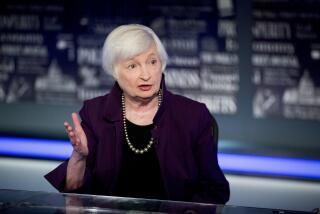‘Mark-to-market’ a stiff standard for banks’ accountability
Given the degree to which the angst and anger about the economy is based on the public’s confusion about the financial world -- just what is a “retention bonus,” anyway? -- this might be the right moment to focus on something simple.
Yes, I’m talking about bank accounting.
Just kidding. Bank accounting is fiendishly complicated. Bankers have always preferred it that way, for it makes it easier to pretend that their institutions are solvent when they’re not.
Their pretense is important because the most valuable asset bankers can own is the confidence of the public -- which, as Adam Smith observed in “The Wealth of Nations,” is worth its weight in gold and silver.
At the moment, confidence in bankers is at a low ebb. The only thing keeping mobs of depositors from the banks’ front doors braying for their money is federal deposit insurance -- and even that hasn’t kept customer panic from bringing down such weakened institutions as IndyMac Bank.
So it’s unsurprising that in an effort to restore confidence, bankers will try anything. One of their main thrusts is to press for a change in their accounting rules, which they say make some banks look sicker than they really are.
Curiously enough, they may be right.
Banks may be heading into a cycle of terrific profitability, in part because they currently enjoy a low cost of capital and the credit support of the federal government. Chastened by the excesses of the recent past, they are taking care to make only the most solid, and therefore profitable, loans going forward.
The top banks’ “earning power . . . has never been better on new business,” Warren Buffett told CNBC a few weeks ago. Just last week, a group of the savviest investors on Wall Street took over IndyMac, convinced that billions can be made from “old-fashioned banking,” as one executive put it. (Especially because the FDIC will eat more than $10 billion of IndyMac’s past losses.)
All that stands between them and Nirvana, the banking industry says, is an accounting rule requiring that they put the absolute worst face on their most questionable loans. Allow them to apply just a bit of rouge and glitter, they say, and they’ll once again be the belles of the financial ball.
This brings us to the concept of “mark-to-market” accounting. If you haven’t heard this term before, brace yourself, because you’ll be hearing it a lot over the next month or so.
Mark-to-market means valuing an asset on your books, or “marking” it, at its market price. Every time you check the action of the stocks in your 401(k) portfolio, you’re mentally marking them to market.
A 2008 accounting rule obligates banks to apply mark-to-market accounting to assets they were holding for eventual sale, such as mortgage pools or mortgage bonds. No one worried about this at first because a thriving market existed for the paper and values were therefore easy to establish.
But almost at the moment the rule went into effect, the market dried up. Because of the perception that trillions of dollars of mortgage-backed securities harbored hundreds of billions of dollars of losses from housing defaults and foreclosures, bond traders suddenly refused to buy the securities at the prices the banks were asking. The banks, meanwhile, wouldn’t sell them for the prices the traders offered.
This left the banks with two related problems: They were stuck with securities they had planned to sell, and they had to write them down to the only prices at which they would trade -- pennies on the dollar. A tsunami of declared losses swamped the banking sector. (We’re still waist-deep in the water.)
Bankers complain that the problem isn’t so much the toxic mortgage bonds on their books but the way they are forced to account for them. They say that mark-to-market, which aimed to tie bank accounting closer to reality (on the principle that any asset is worth only what people will pay for it), actually distorts reality.
There isn’t a genuine market for mortgage assets at the moment, they say, so prices are being set by a few panicky institutions engaging in fire sales. They draw an analogy with the price you’d get for your home if you took three or four months to wait for the best offer versus what you’d get if you had to sell it by noon today.
These are the same assets, by the way, that are the subject of the new bank rescue plan to be unveiled by the White House today. The plan would transfer these assets to the Treasury or private investors who won’t need to dump them quickly. But it’s proper to note that if mark-to-market is liberalized, some banks will demand higher prices from the Treasury for their so-called toxic waste.
“Market prices are all being driven by institutions with their backs to the wall, selling at desperation prices,” William Isaac, a former chairman of the Federal Deposit Insurance Corp., told me recently. He blames the accounting rule for much of the damage in the banking sector that made the $700-billion federal TARP bailout necessary.
There’s a vigorous debate about that. Last year, the Securities and Exchange Commission told its staff to investigate the banks’ claims that mark-to-market caused the financial meltdown. The staff produced a densely footnoted study that ran to 209 pages, the conclusion of which could be boiled down to a single word: baloney. The banks’ fundamental problem, it said, was that their sloppy mortgage standards produced a lot more defaults than they bargained for.
Others, including a study group headed by former Federal Reserve Chairman Paul Volcker, agree with the bankers that mark-to-market is the right way to value the activity of your trading floor but not a bank’s core business of borrowing short and lending long.
The Financial Accounting Standards Board, an independent body that sets standards for U.S. companies, has already signaled that it will relax the rule in April, in time for the banks’ first-quarter financial reports. FASB says it will allow bankers to use “significant judgment” in valuing assets where no active market exists.
But revamping the rule still leaves uncertainty about what should go in its place. The nation’s big banks grossly overvalued their mortgage assets for years; no one doubts that billions in write-downs still lie ahead. Mark-to-market was supposed to be an antidote for their tendency to, well, lie.
“The credibility and acumen of management has been raked over the coals,” observes Robert Willens, a former executive of Lehman Bros. who consults privately on financial and tax matters.
The bankers promise that this time, they’ll be perfectly transparent about how they value their toxic assets -- that they’ll apply rigorous projections of expected default rates and income streams and that they’ll show their scratch paper. Some in the industry, like former FDIC honcho Isaac, believe the process will allow them to write up the value of assets they’ve overwritten down.
FASB’s announcement suggests the bankers are almost certain to be given the chance to show they’ve reformed, like a purse-snatcher turned out on the street with a stern warning from a lenient judge. The economy needs them filling the role of good corporate citizens. Will they seize the opportunity to behave, or go back to their old ways and mug the first old lady they come across?
--
Michael Hiltzik’s column appears Mondays and Thursdays. Reach him at michael.hiltzik@latimes.com and read his previous columns at www.latimes.com/hiltzik.
More to Read
Inside the business of entertainment
The Wide Shot brings you news, analysis and insights on everything from streaming wars to production — and what it all means for the future.
You may occasionally receive promotional content from the Los Angeles Times.









